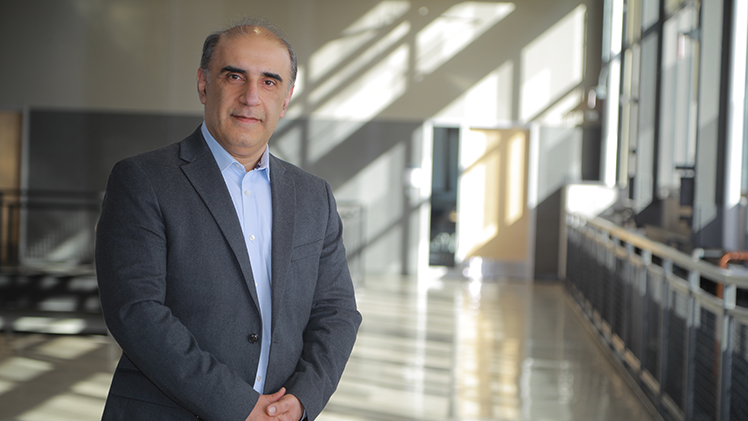The Large Hadron Collider extends 17 miles beneath the France–Switzerland border near Geneva, a lengthy runway that, among other factors, allows the collider to accelerate charged particles to mind-bogglingly high speeds.
At The University of Toledo’s Adaptive Radiofrequency and Plasma Lab, Dr. Abbas Semnani and his team of researchers are exploring the potential of particle accelerators that can reach comparable speeds with a significantly shorter runway — a revolutionary technology that could transform particle accelerators’ practical applications in cancer treatment, medical isotope production, material development, security imaging and more.

Dr. Abbas Semnani heads the Adaptive Radiofrequency and Plasma Lab at the UToledo College of Engineering.
“We want to make them meters long instead of miles long,” said Semnani, an associate professor in the Department of Electrical Engineering and Computer Science.
The U.S. Department of Energy recently awarded Semnani $647,500 to develop energy-efficient cold plasma line sources tailored for laser-plasma accelerators in collaboration with the Lawrence Berkeley National Laboratory in California.
Particle accelerators are vital for advancements in science and technology, as well as enabling ground-breaking research in particle physics. Because laser-plasma accelerators generate electric fields far exceeding those of traditional radiofrequency accelerators, they offer a significantly more compact alternative to facilities like the mileslong collider at the European Organization for Nuclear Research (CERN).
“Microwave-excited plasmas, renowned for their efficient energy transfer and high ionization levels, are central to the effort to develop novel laser-plasma accelerators,” Semnani said. “Building on our existing body of research on energy-efficient microwave plasma jets and their applications in biomedical treatments, surface modifications and PFAS removal, we will focus on developing advanced microwave resonant structures to produce high-density and long plasma lines essential for next-generation laser-plasma accelerators.”
PFAS, known colloquially as “forever chemicals,” are a widely used class of chemicals whose components break down very slowly over time.
Semnani, whose work was also recognized with a prestigious CAREER Award through the National Science Foundation in 2024, is new to the world of these particle accelerators. But he brings a valuable expertise in plasma science to physicists’ efforts to advance the technology.
Plasma, identified as the fourth state of matter, is an ionized gas with wide-ranging applications including medicine, food preservation, water treatment, electric propulsion and semiconductor fabrication.
Microwave plasmas that are formed when a gas is ionized by microwave energy are one of several lines of research that Semnani and his research team are exploring. Their work so far on these high-efficiency plasmas, yielding two patent applications and one issued patent, has been funded by the National Science Foundation.
The new energy department-supported project presents a new avenue of research for the lab, with the researchers now challenged to tailor these high-efficiency microwave plasmas for use in laser-plasma accelerators.
The three-year collaborative project furthers the relationship between UToledo and the Department of Energy’s National Laboratories, whose researchers have collaborated on topics ranging from solar energy to harmful algal blooms.
In addition to establishing a new research frontier in plasma-driven particle physics, the current project will also strengthen the infrastructure and research capabilities of Semnani’s Adaptive Radiofrequency and Plasma Lab. The grant funding allows for purchase and installation of a state-of-the-art intensified charge-coupled device (ICCD) camera capable of capturing images at nanosecond time scales. It will also partially support a research assistant professor and fully support two graduate students to work with Semnani.
“This grant further cements our lab’s leadership in electromagnetics and plasma science, creating new opportunities for cutting-edge research and innovation in medicine, security and material science,” Semnani said.